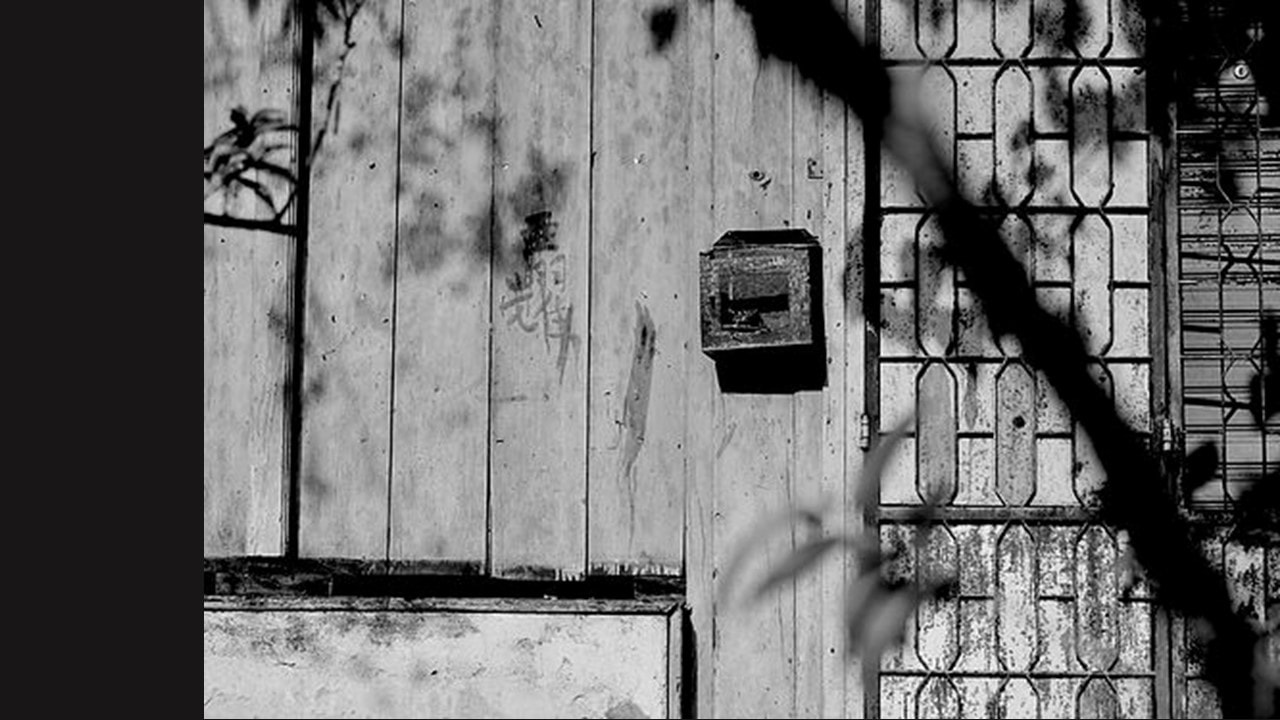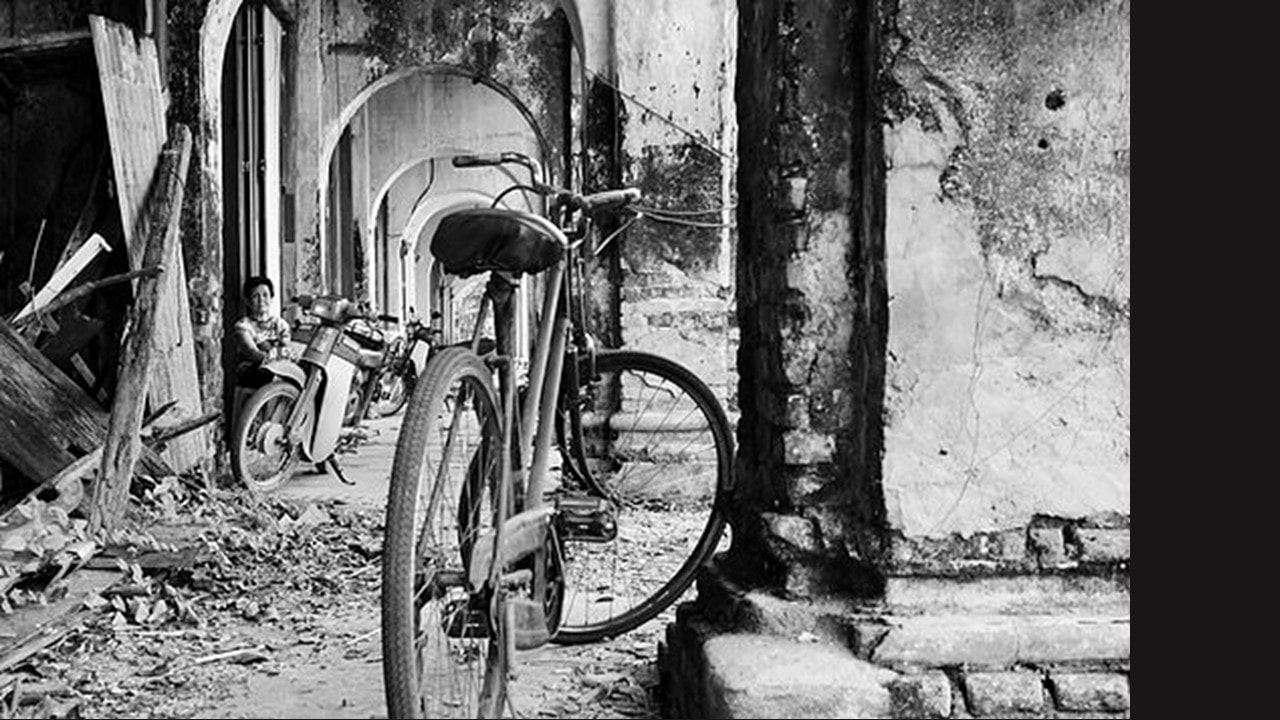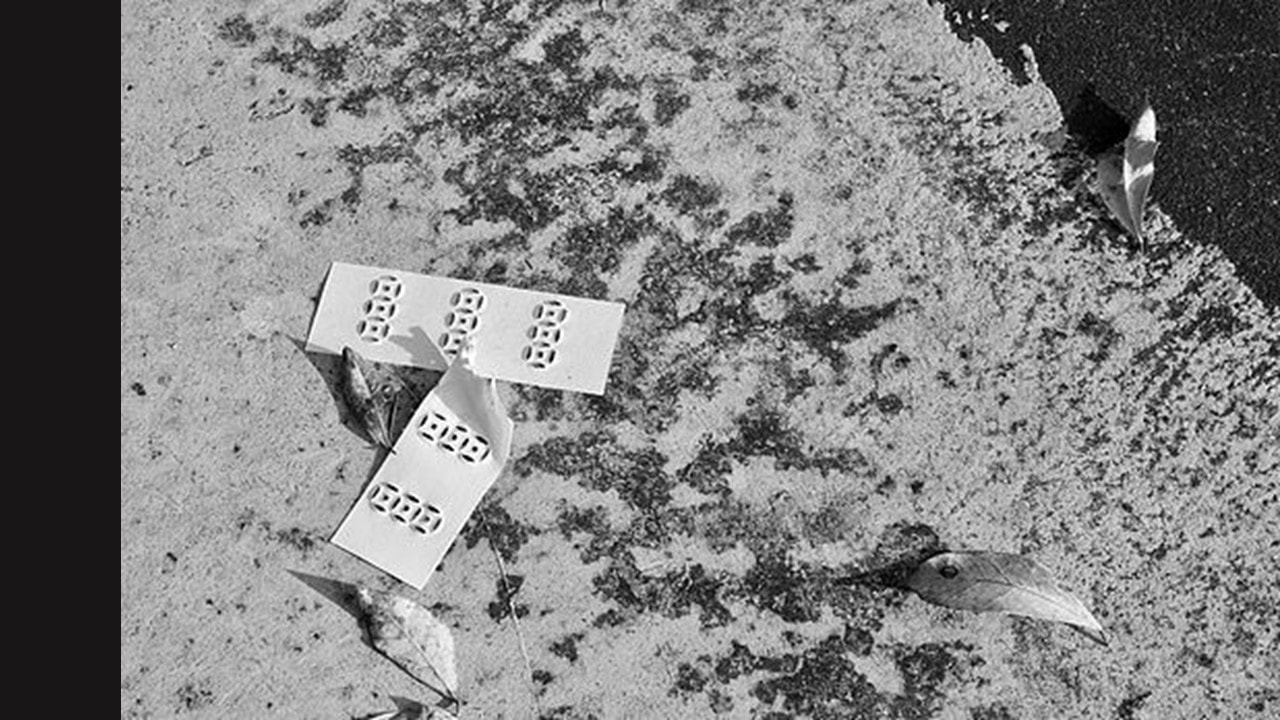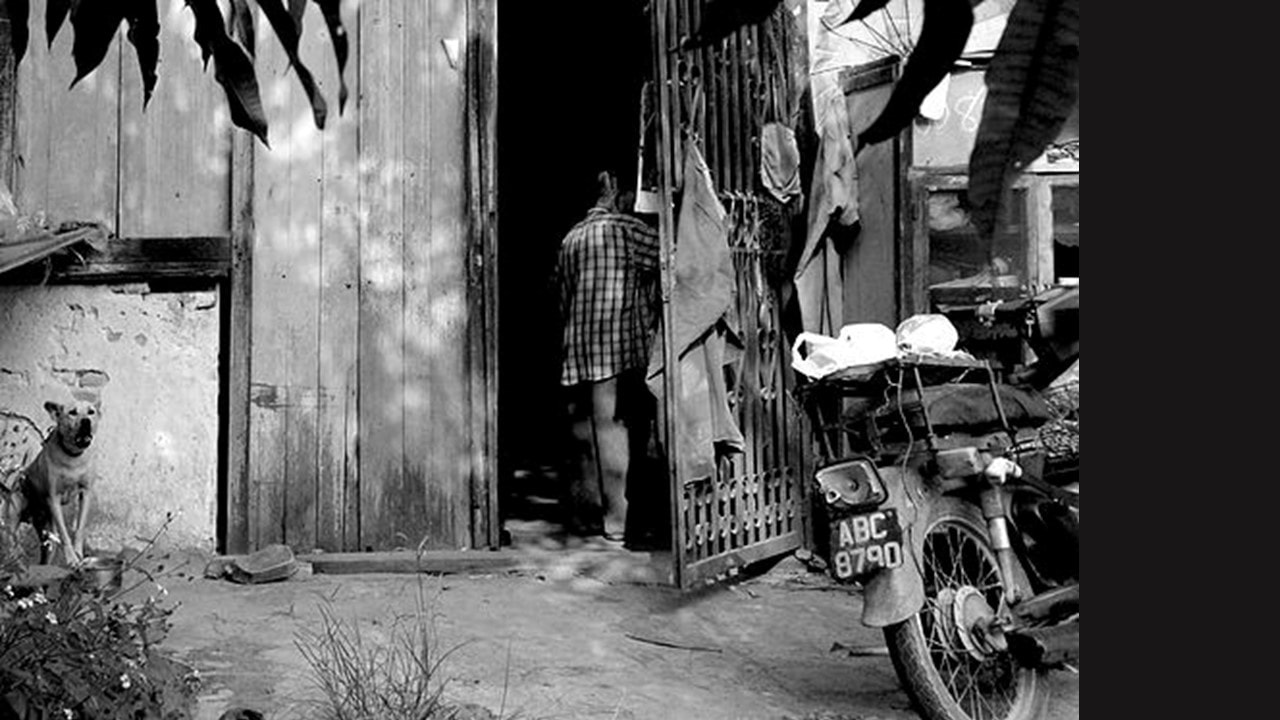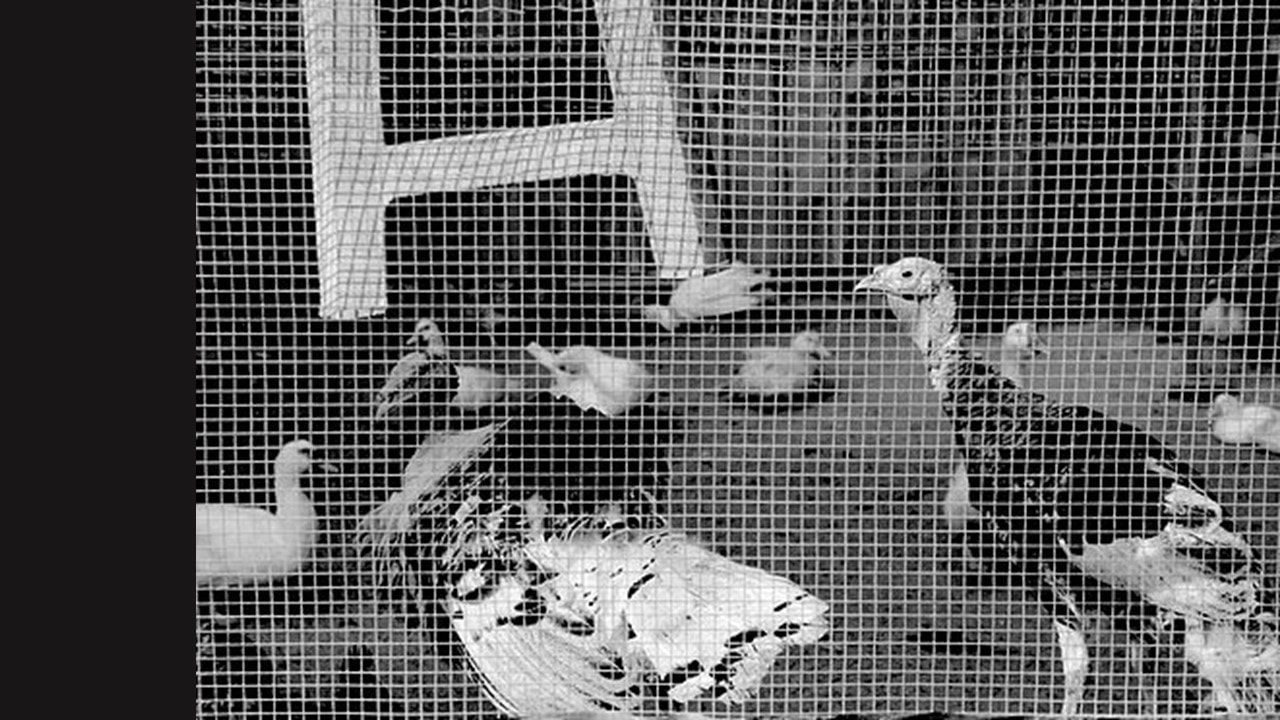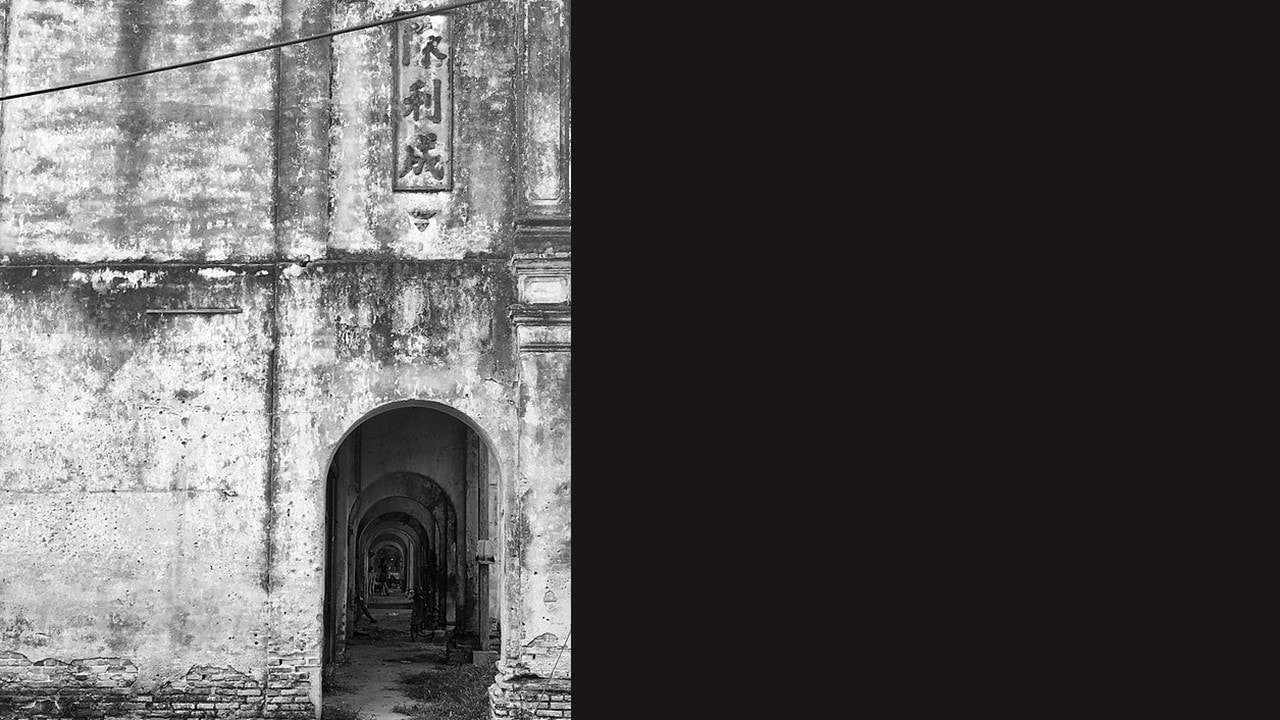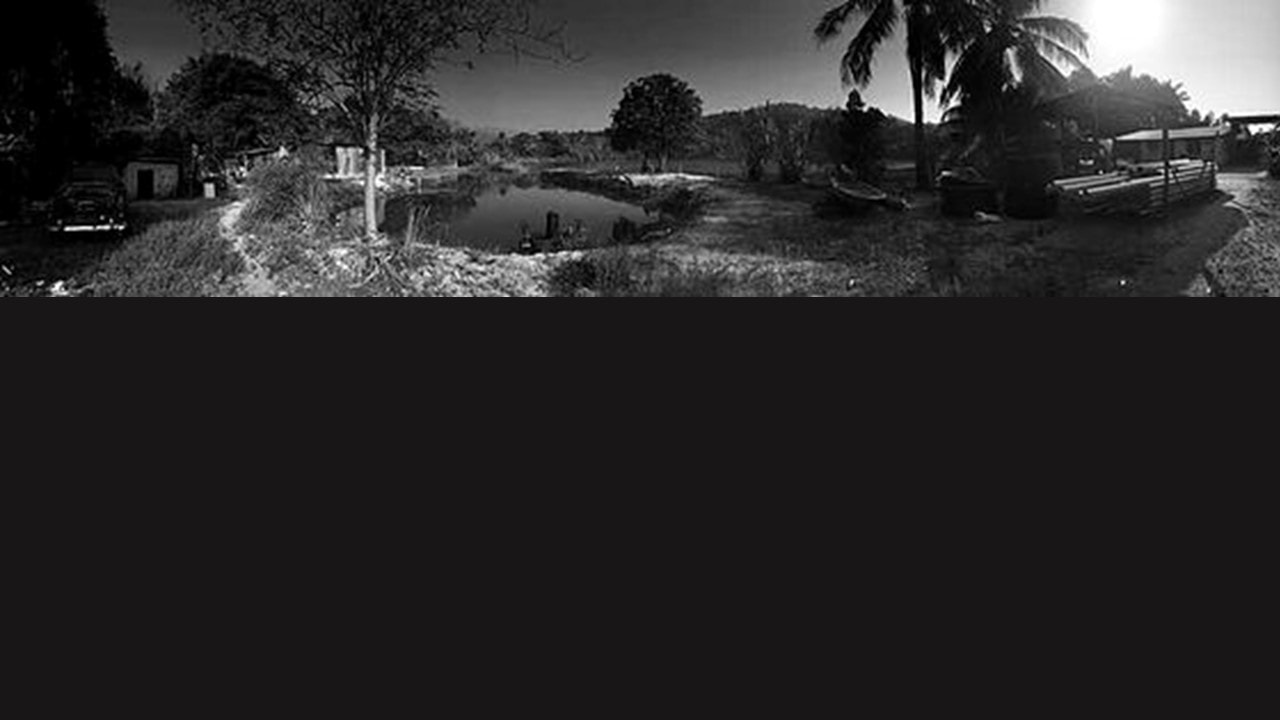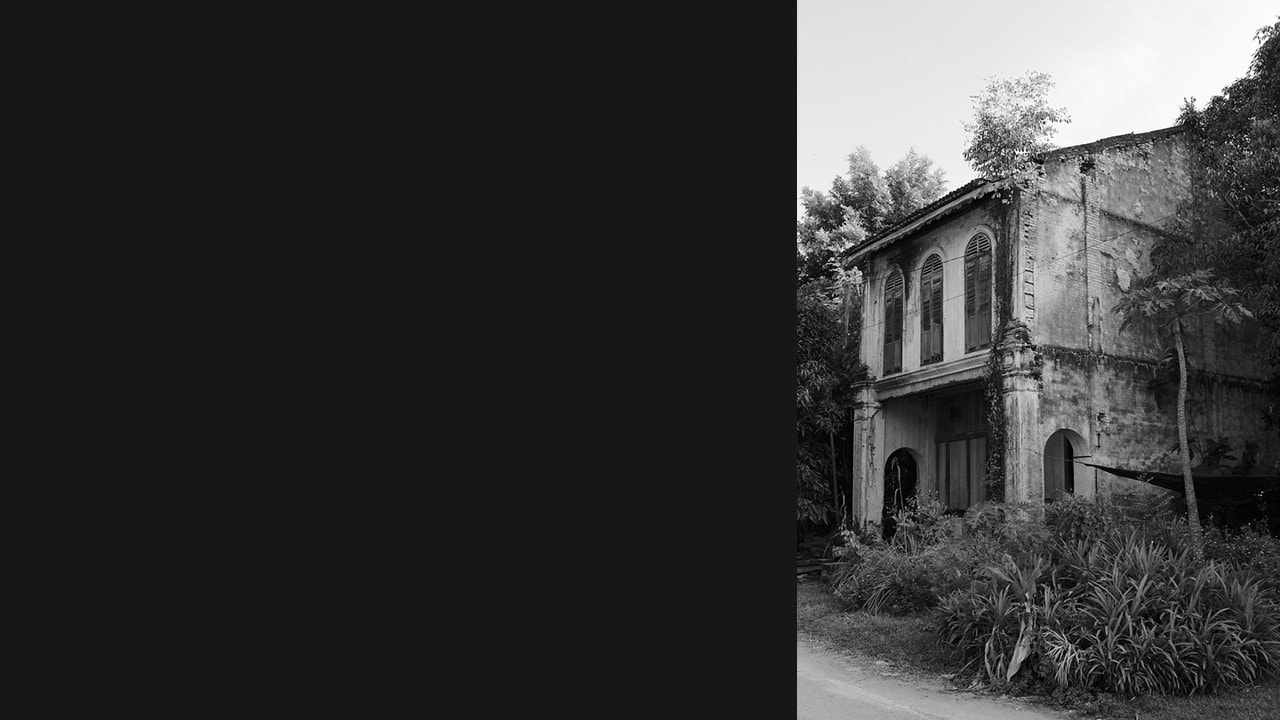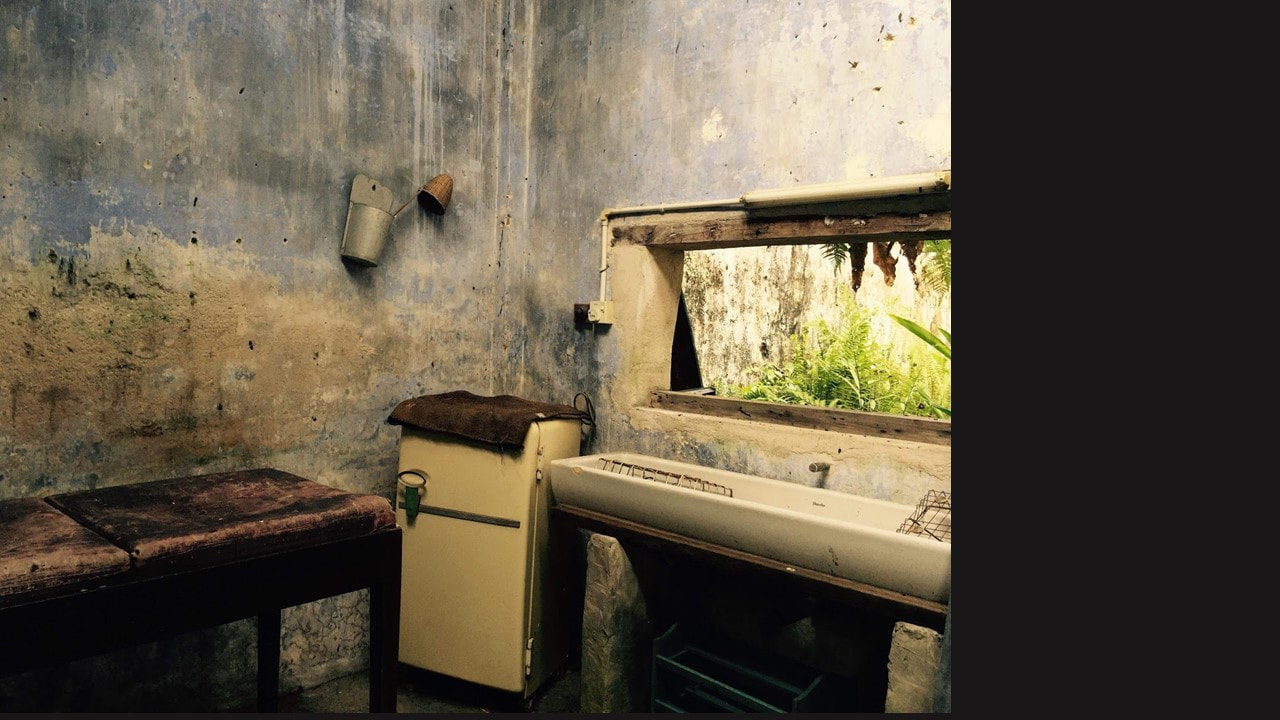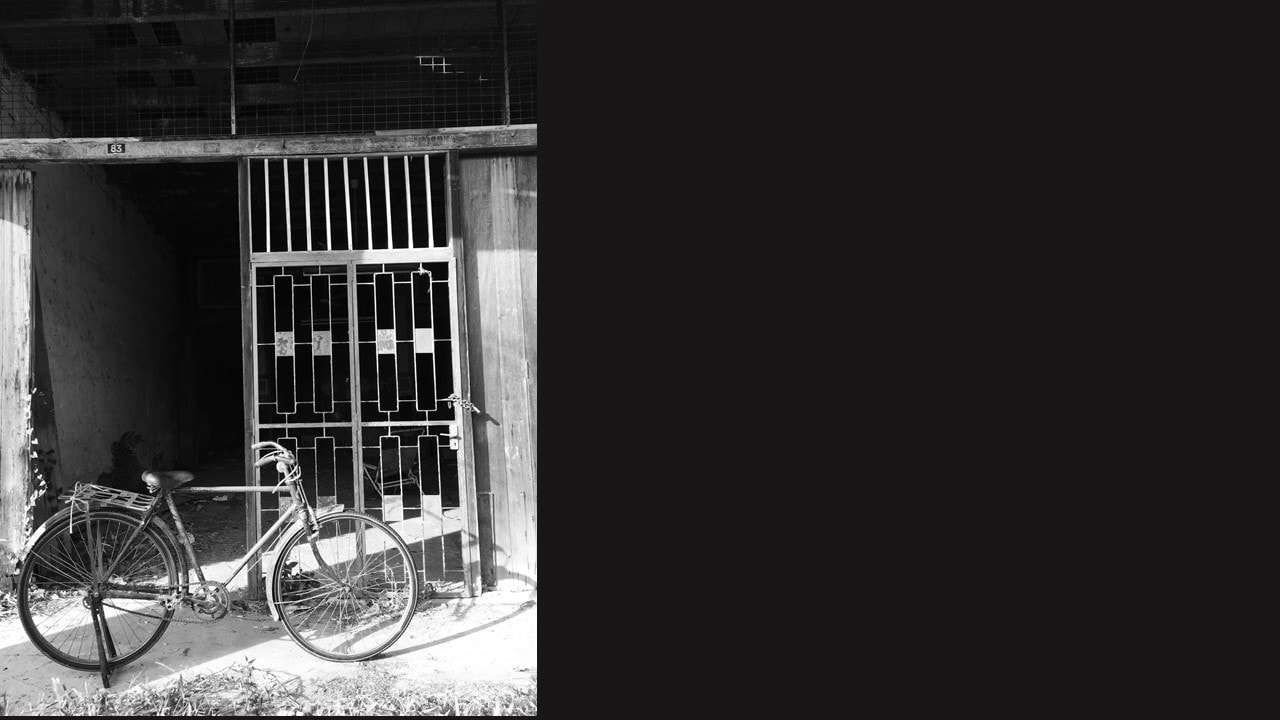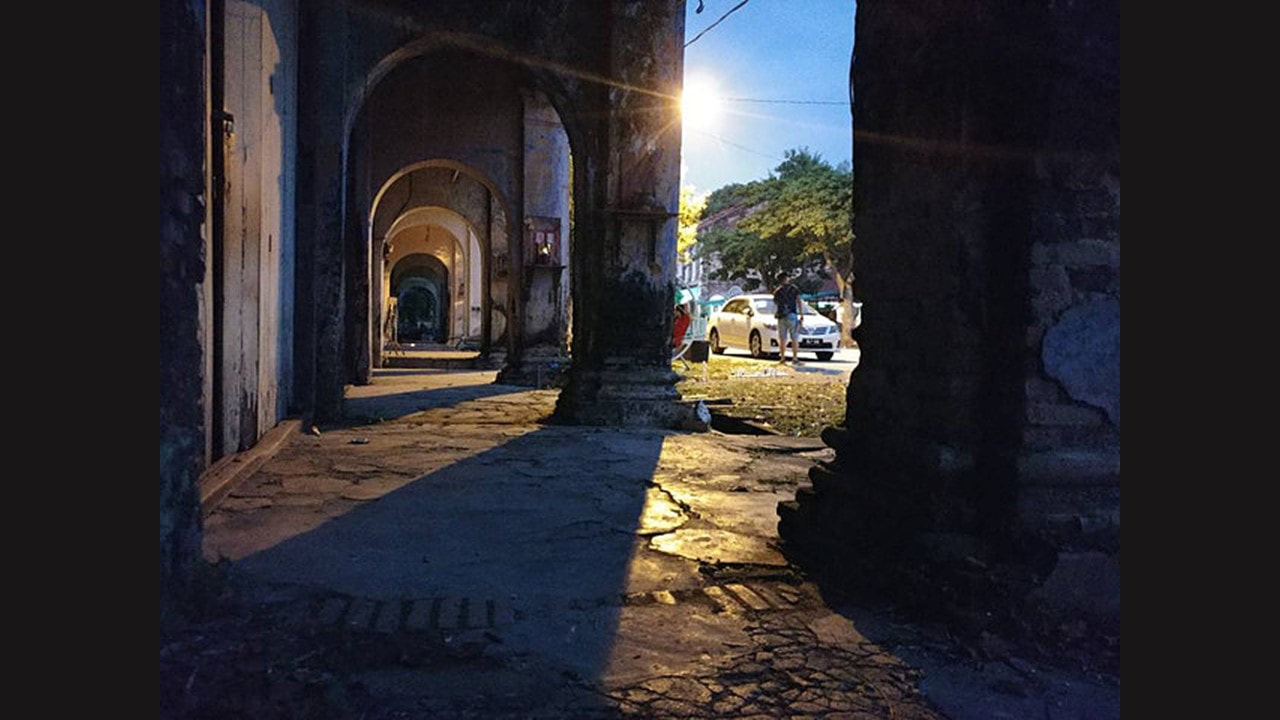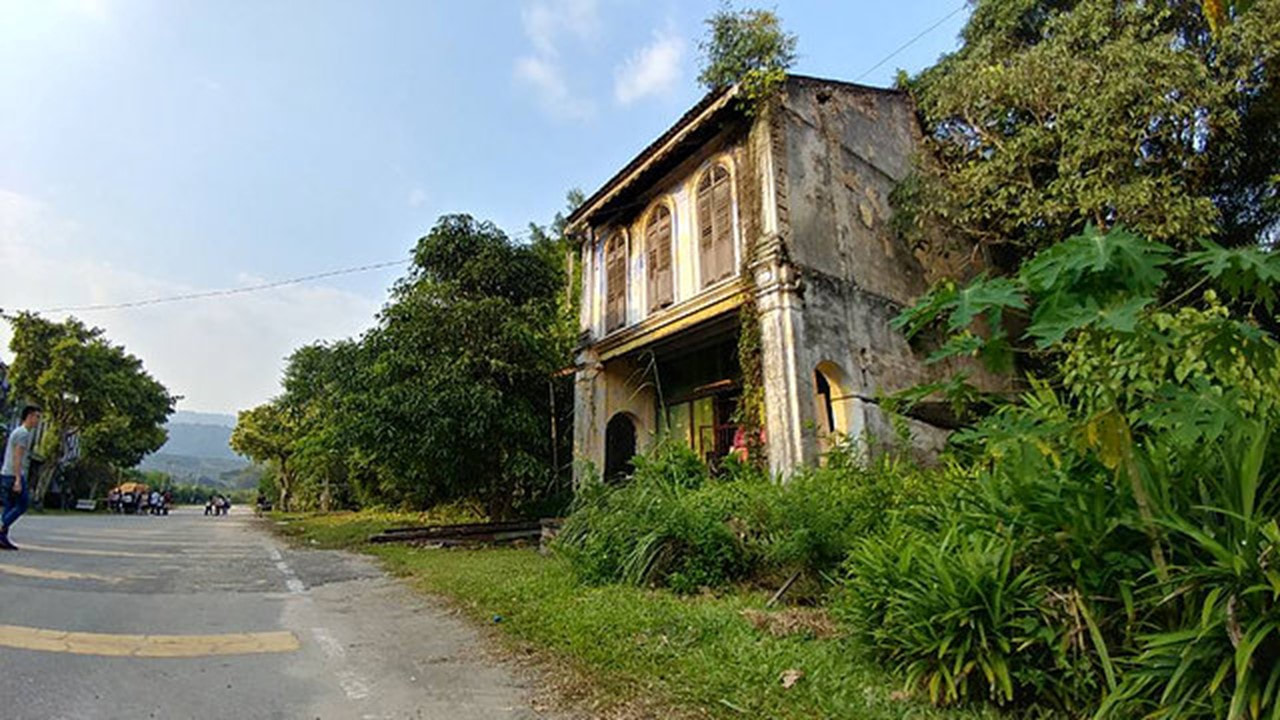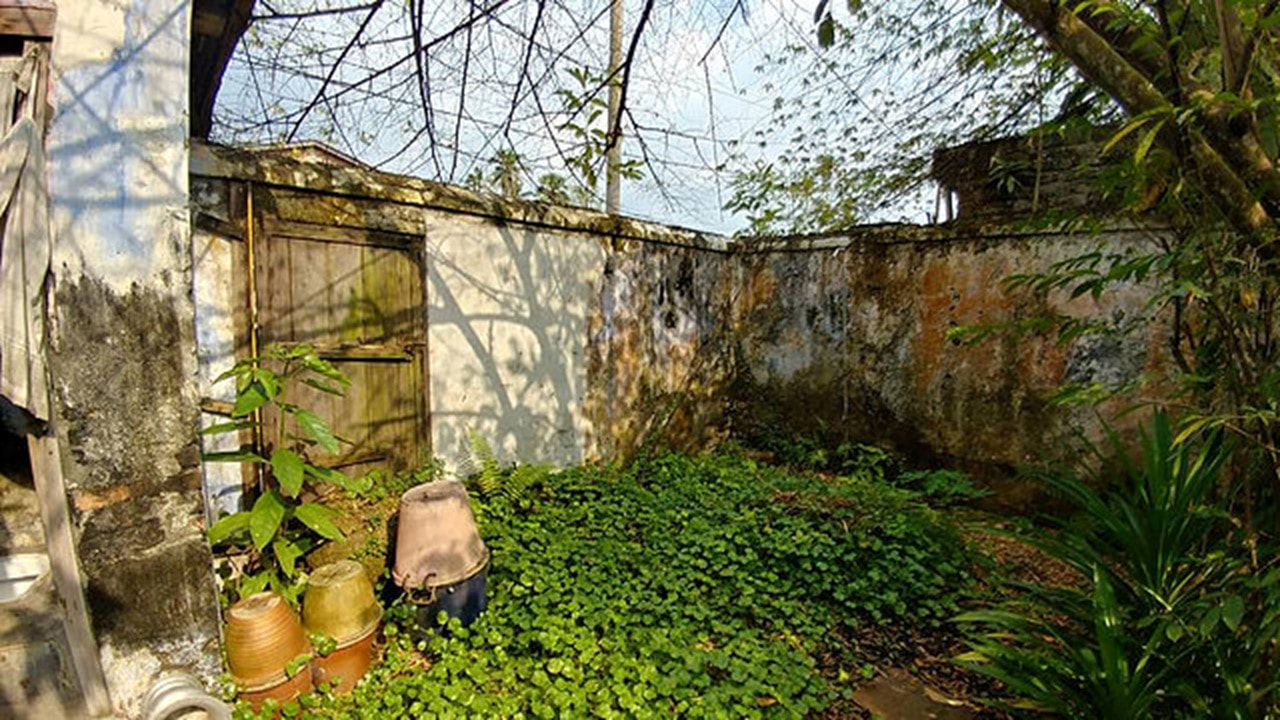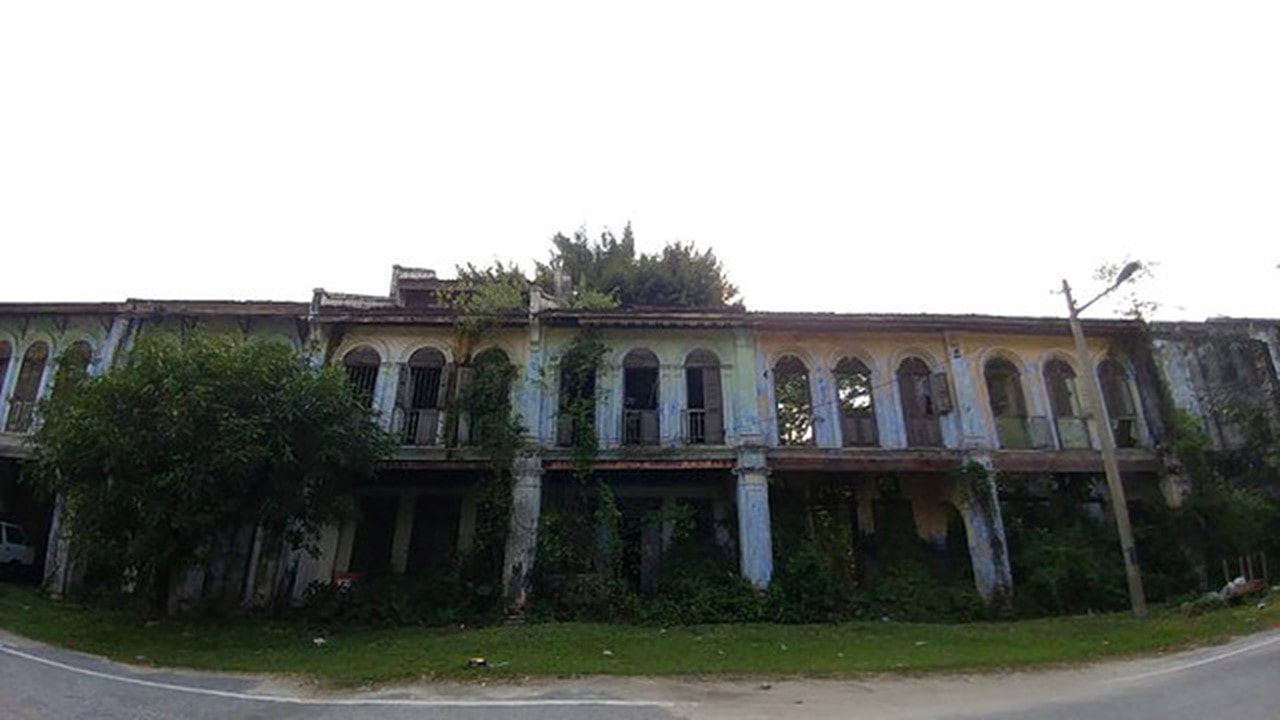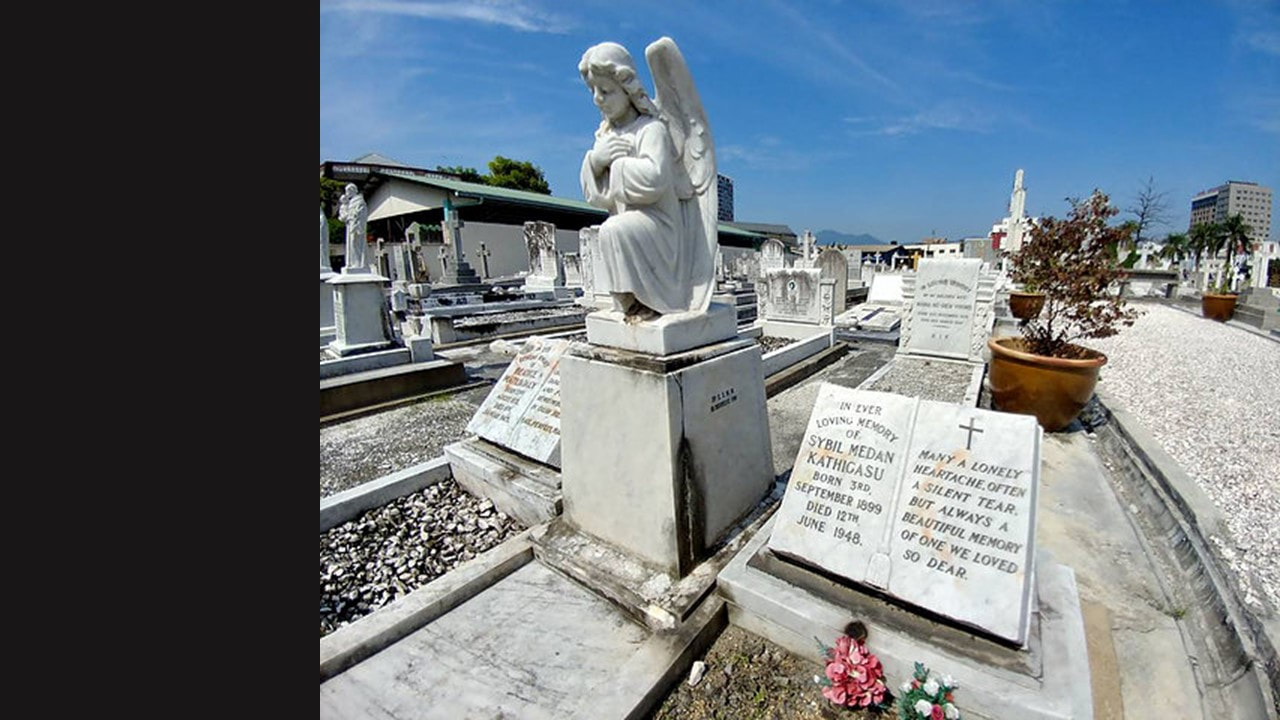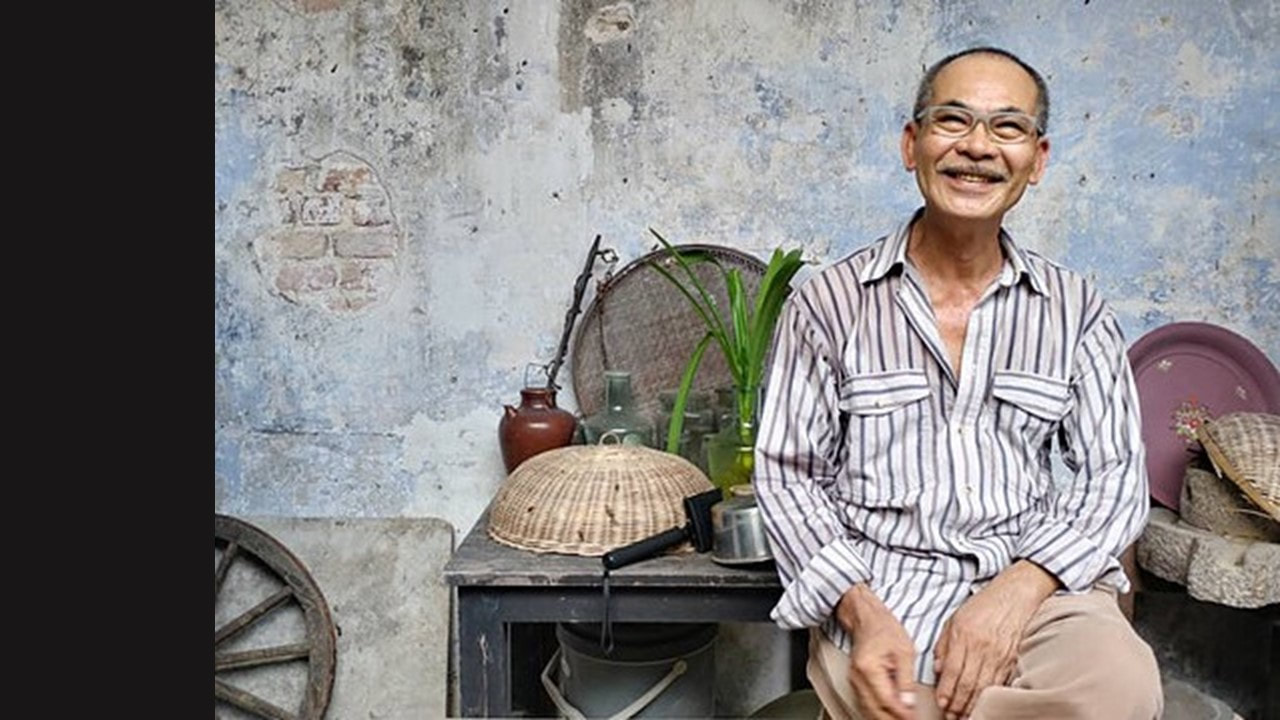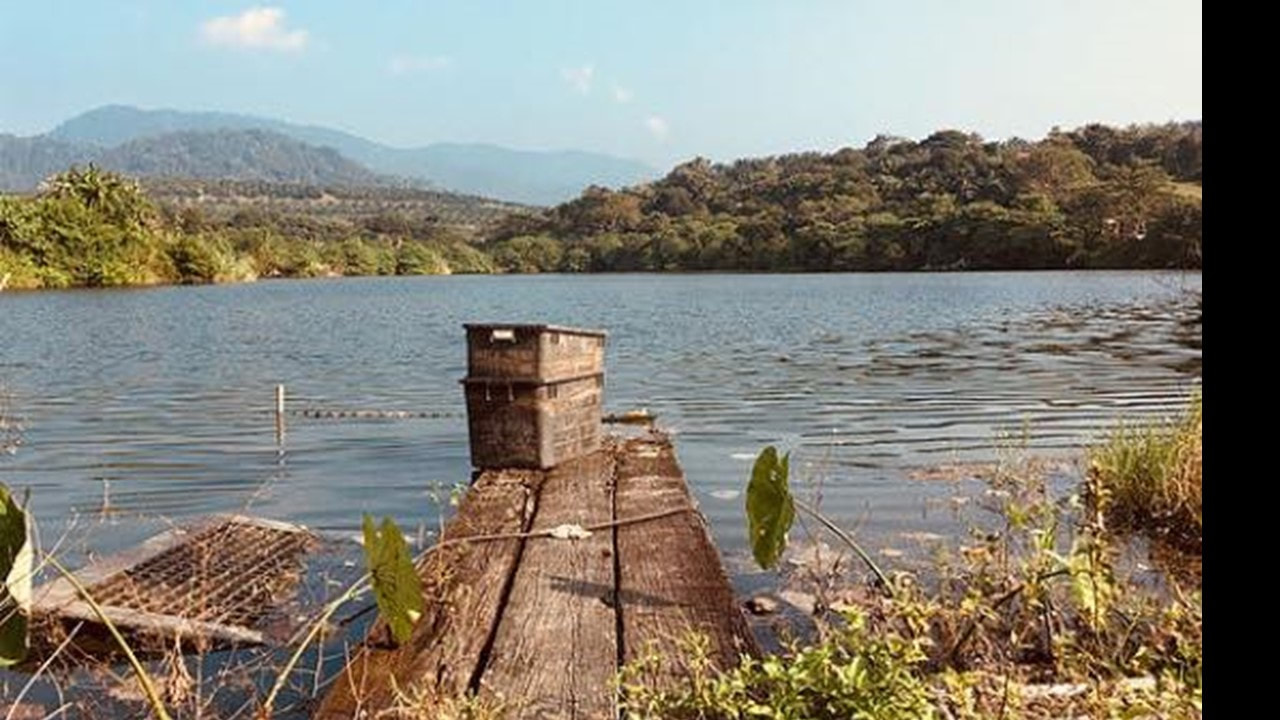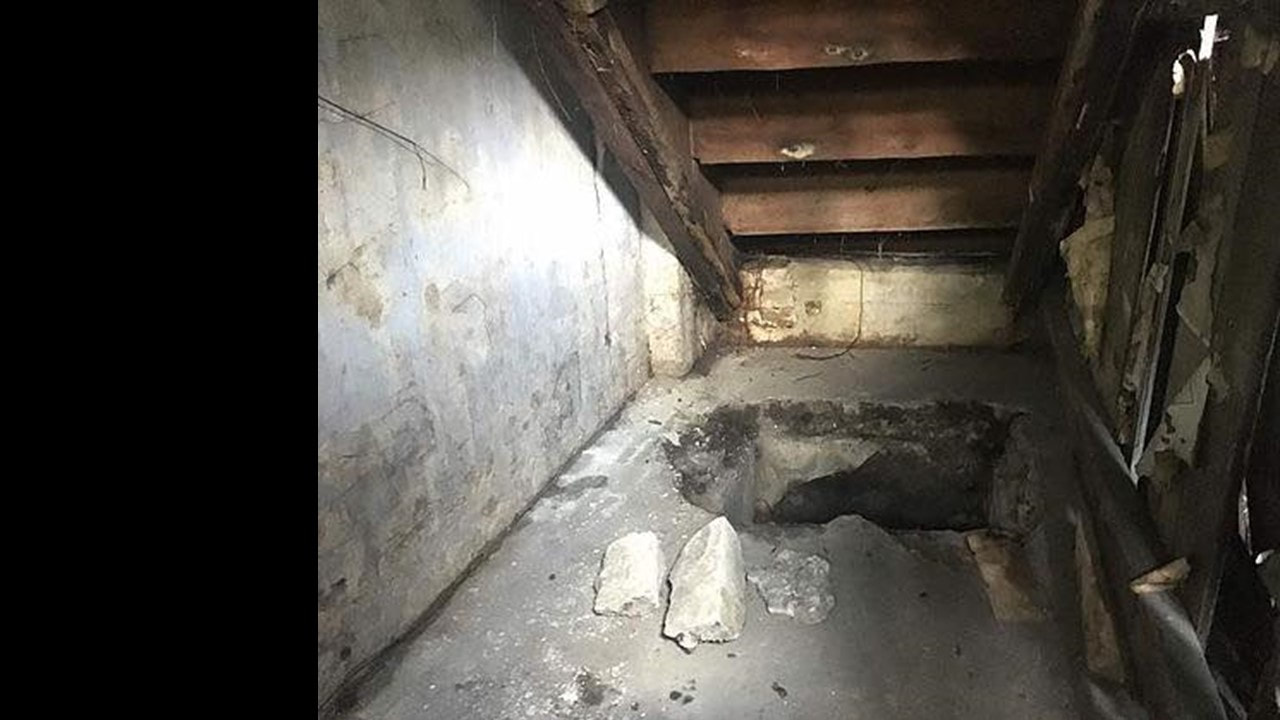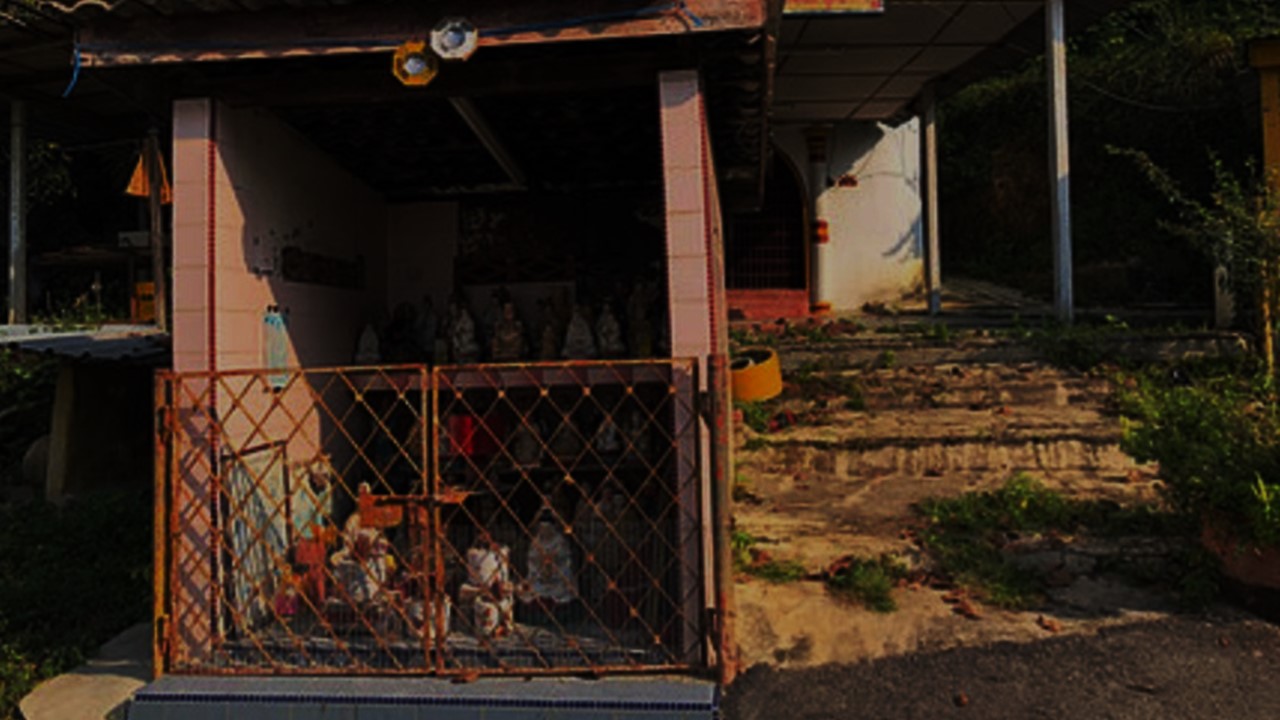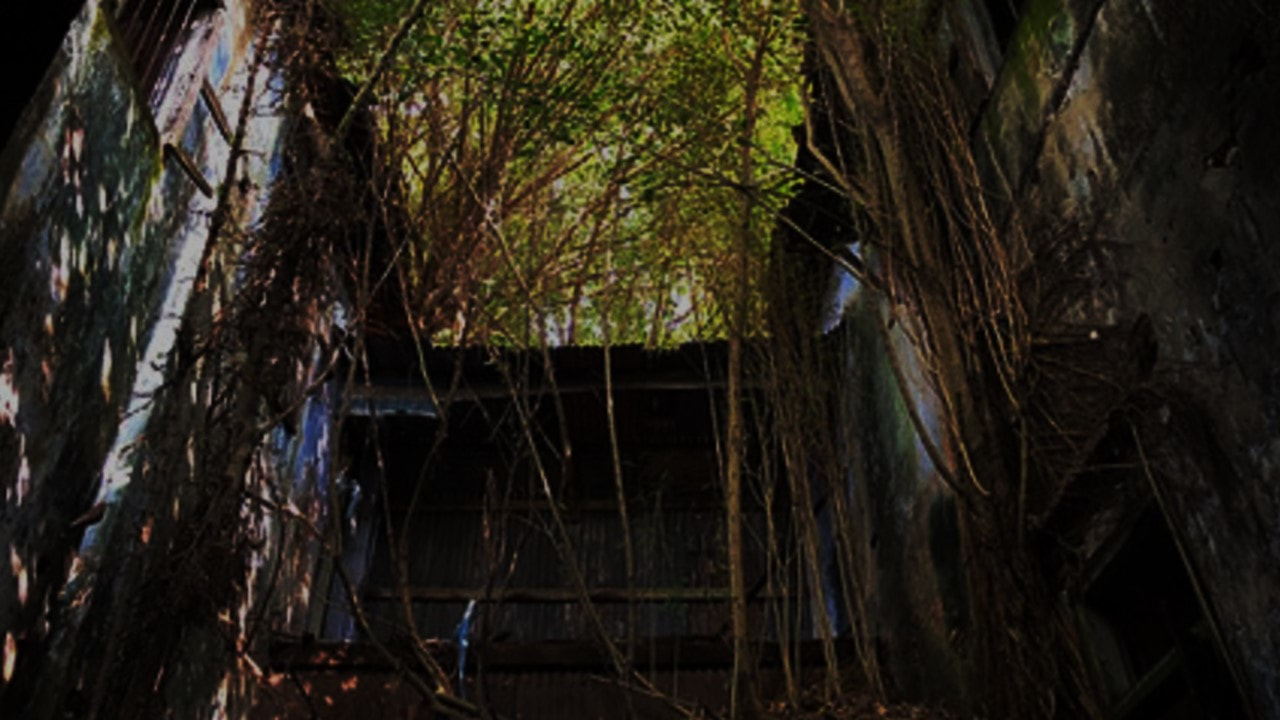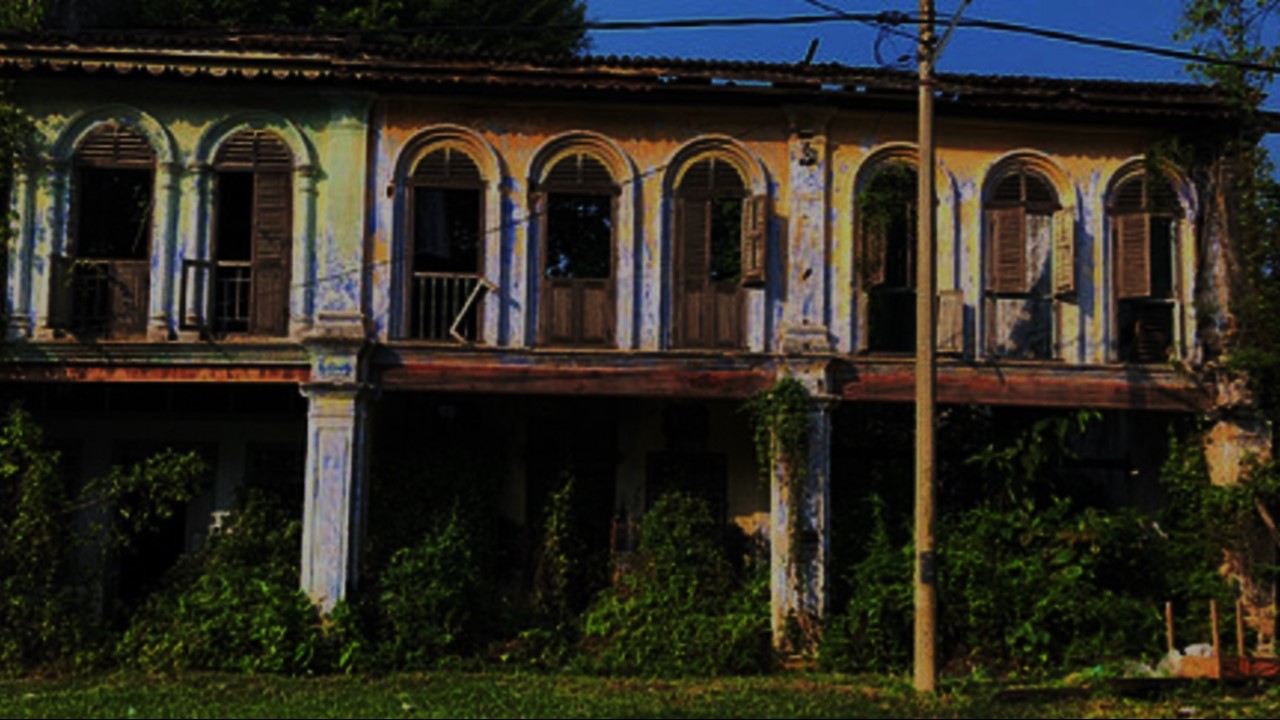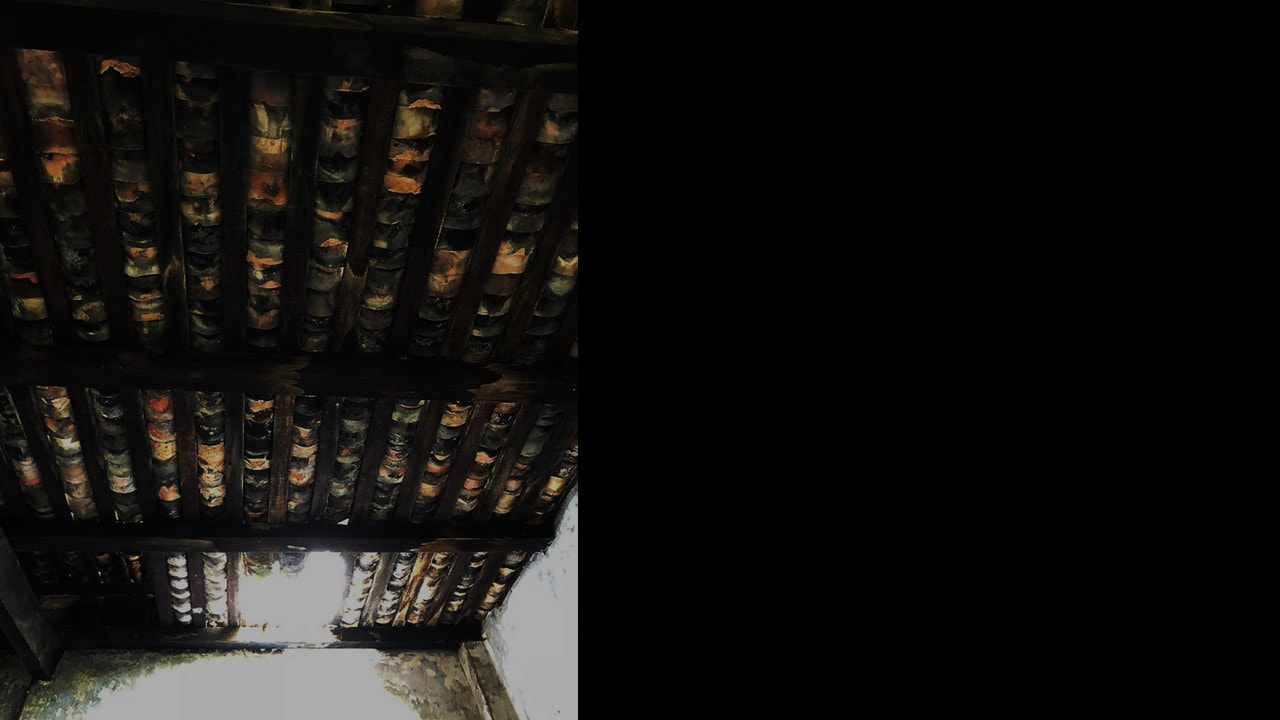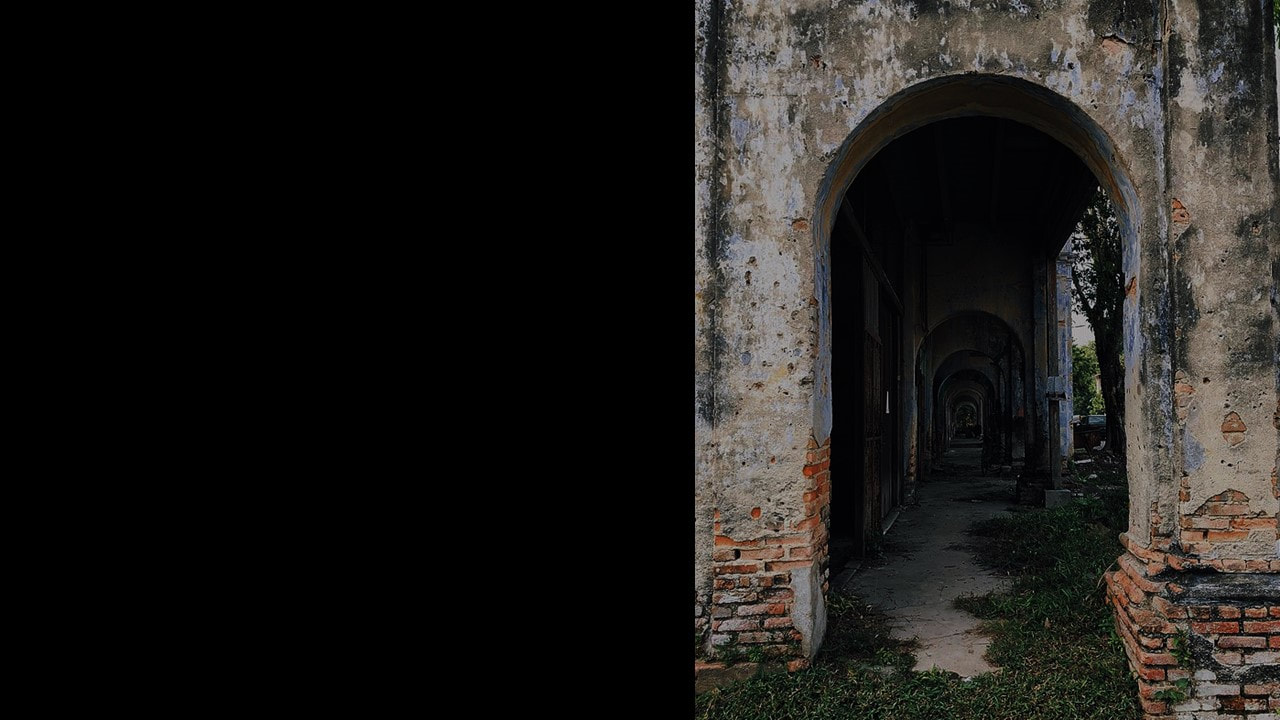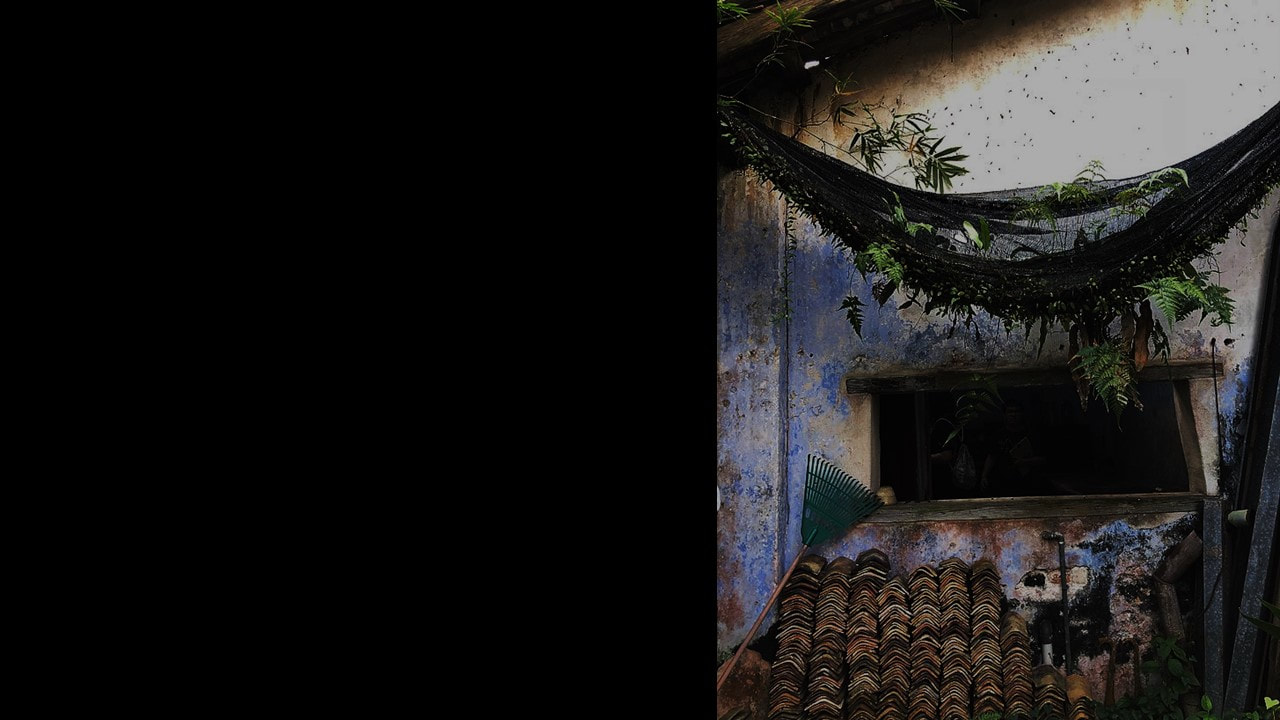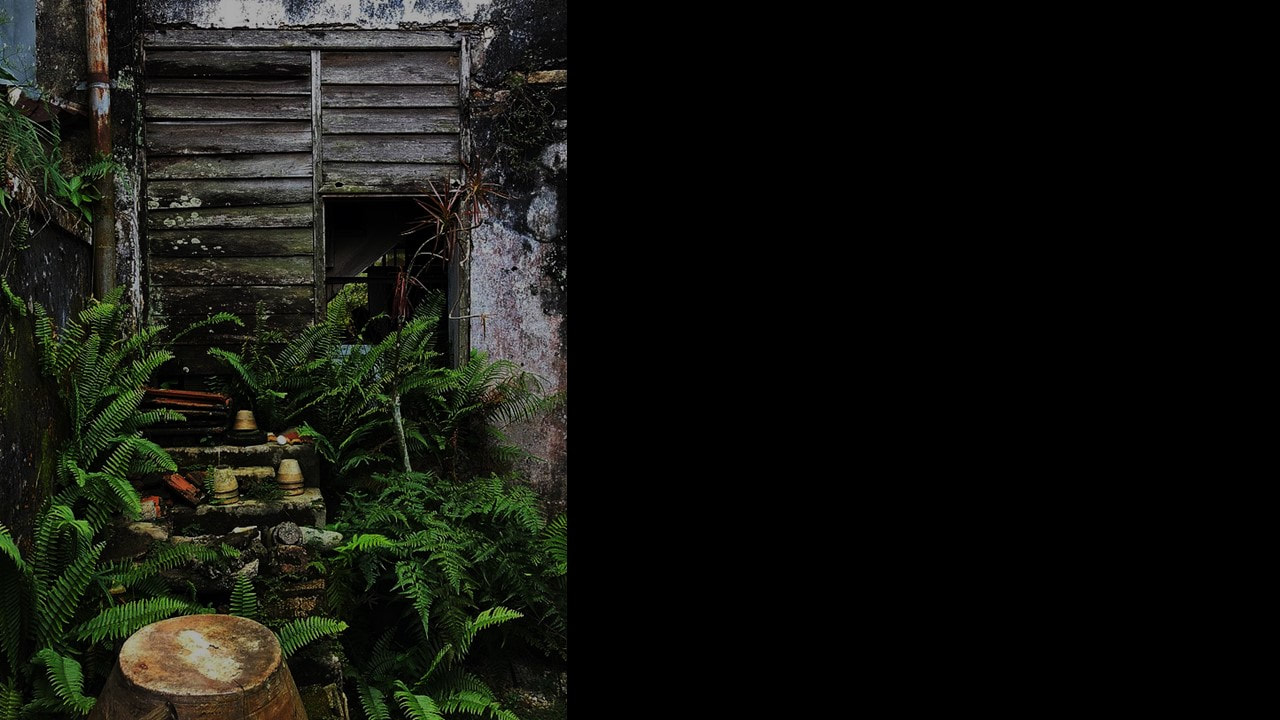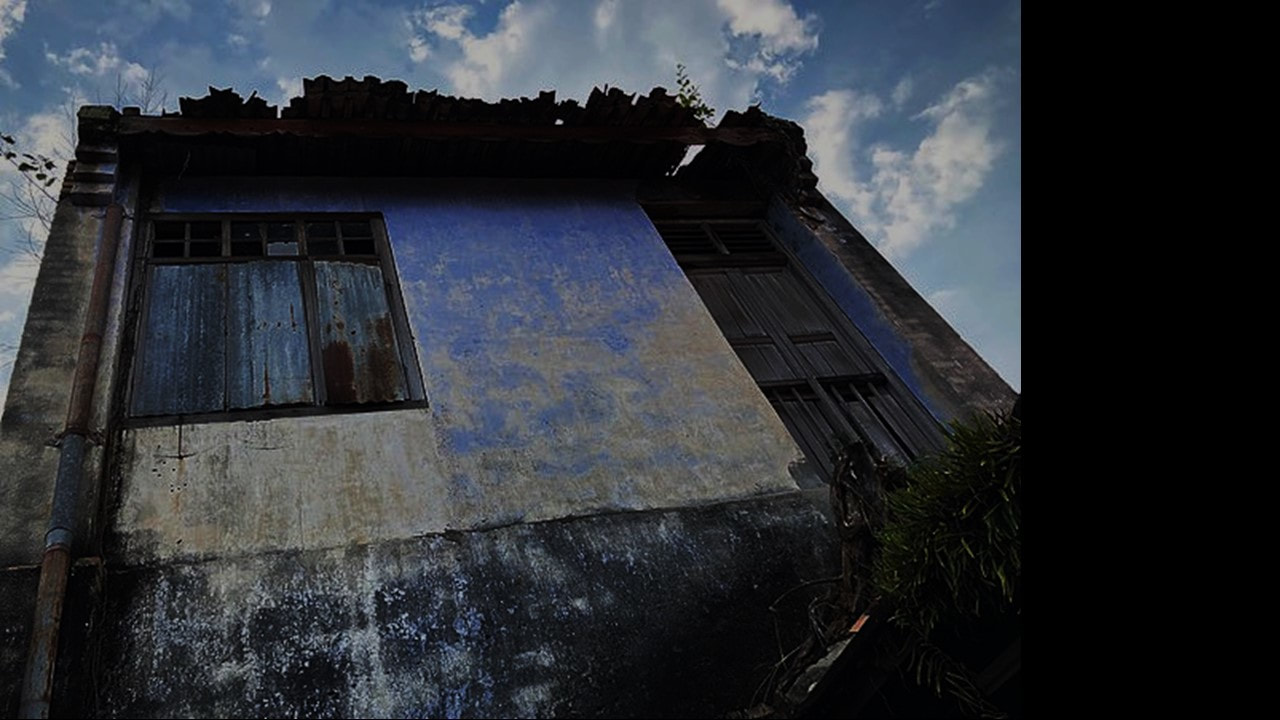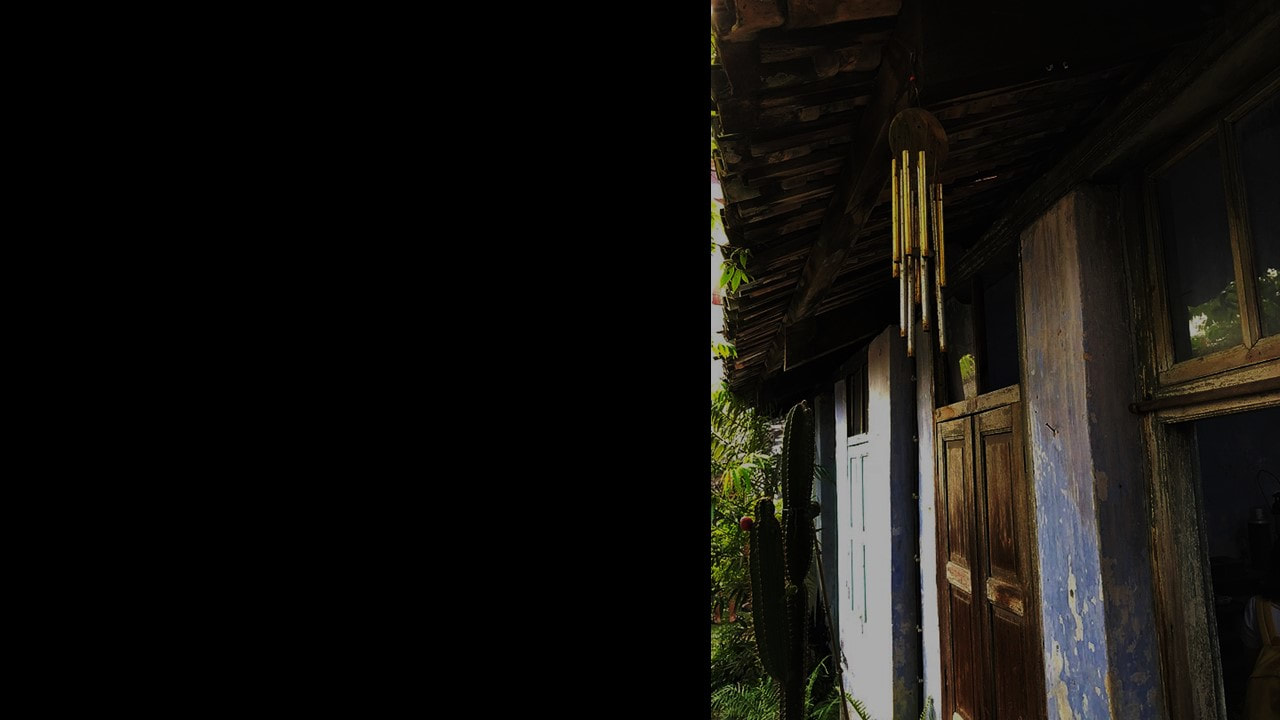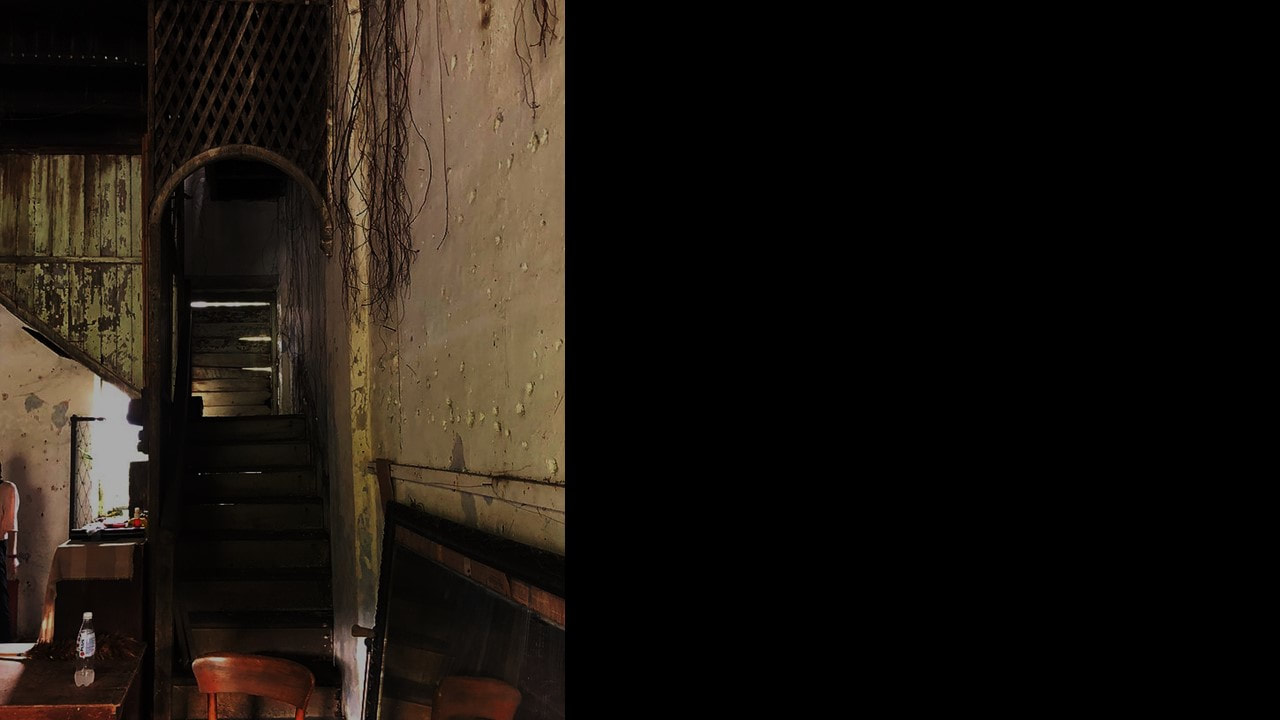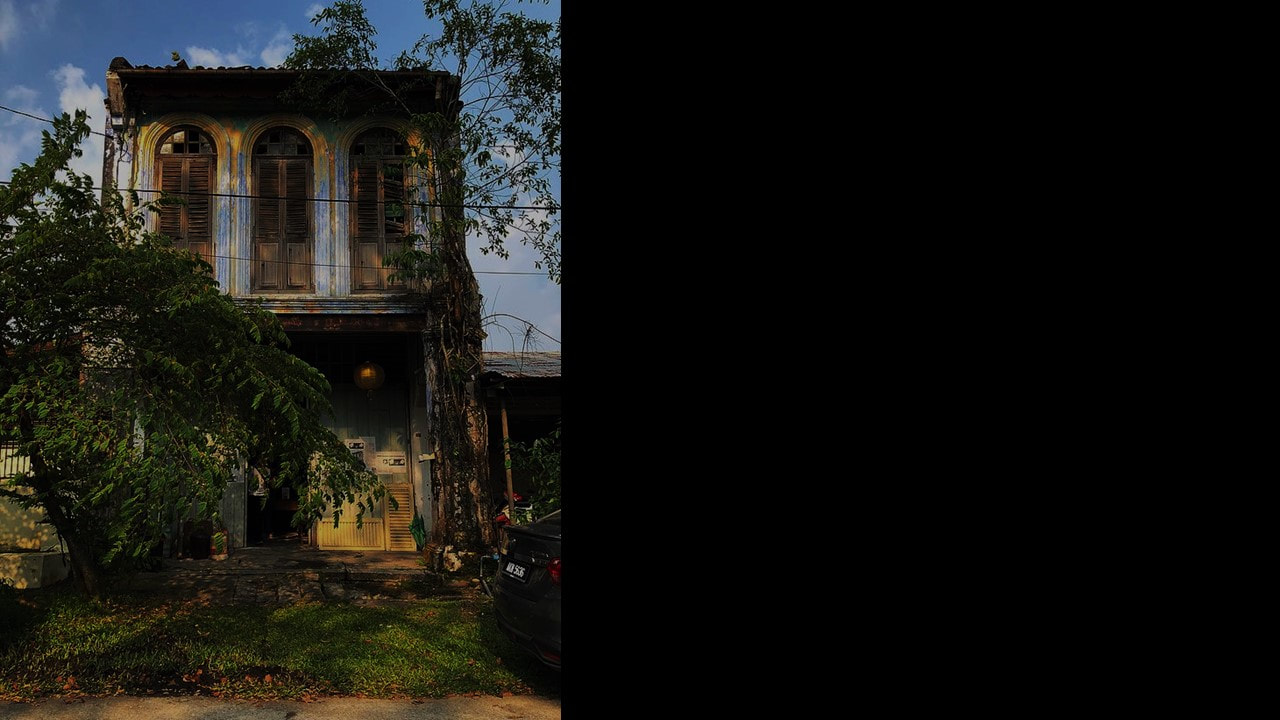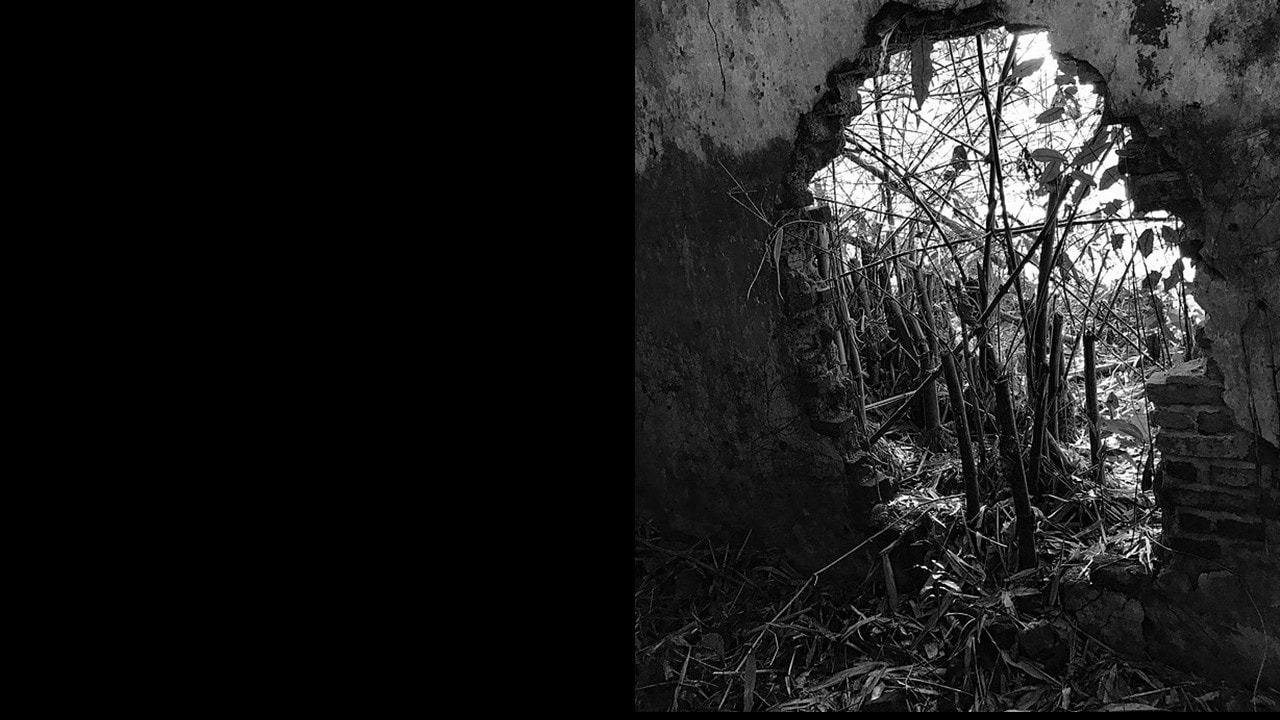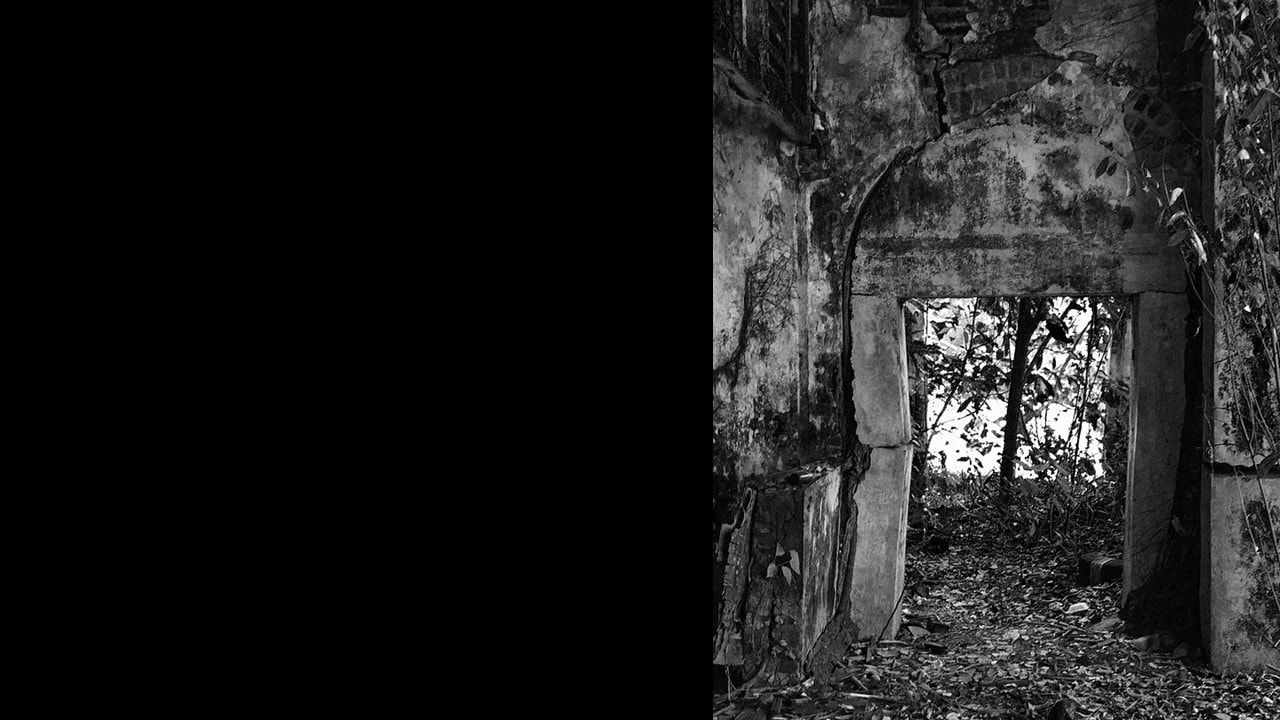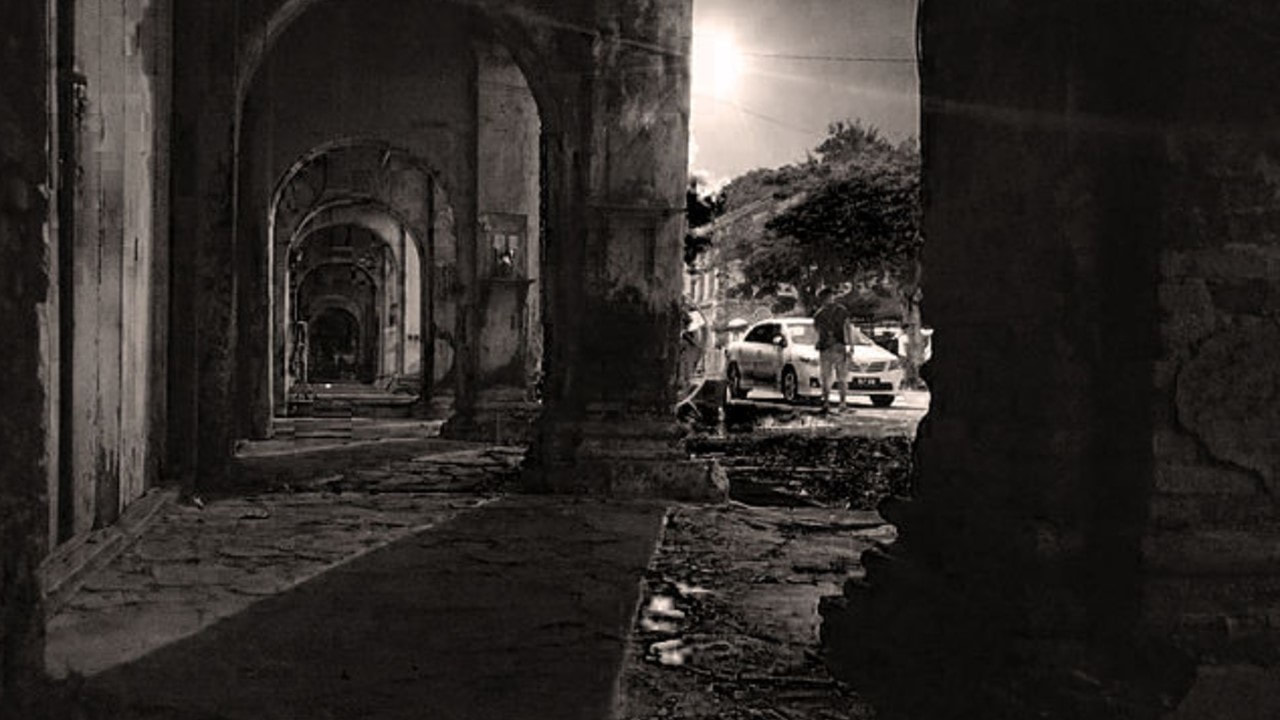STAGE : PAPAN PERAK
The approach to Papan is strangely scenic -- giant rain trees growing along a winding stream, limpid mining ponds, a hill slope dotted with Chinese graves, a Kuan Yin Temple, then suddenly in the middle of nowhere, a brick and mortar streetscape. A nineteenth century mining town petrified in time. Two seemingly desolate rows of shophouses, some barely standing, along a street simply called 'Main Road'. The remains of a boomtown that once stood in the midst of tin-fields as far as the eye could see. Remarkably, Papan begins to show signs of life towards sunset, when children come out to play and residents get home from work. Old friends hang out and chatter in the town's only two coffee-shops. Just off the Main Road is the house of Raja Bilah (died 1911), the headman of Papan. The Sumatran nobleman's remarkable career as miner-trader-adventurer and leader of his people has inspired a book Raja Bilah and the Mandailings of Perak: 1875-1911 described by an American historian as 'the most exciting book on Malaysian history' she has ever read. The great house was restored by the National Museum several years ago. - http://www.lestariheritage.net/perak/webpages/papan01.html
Papan town and Raja Bilah's house have been used as film set, most notably by Oscar-winning production designer Luciana Arrighi for the movie Anna and the King (1999). Luciana was fascinated with Papan -- a near ghost town on the edge of large mining lakes, set in a mysterious cul-de-sac, shrouded and surrounded by dark, forested hills. The hills around Papan belong to the Hijau range. Once they were not so peaceful, but reverberated with the sound of gunfire. Sinuous jungle trails, now popular with nature-lovers, used to lead to guerrilla hide-outs. They were first used by hill rat miners, then by the Papan armed resistance and finally by Communist insurgents during the Malayan Emergency (1948-1960). Half a century after her death, Sybil's clinic at 74 Main Road was turned into a gallery interpreting the story of Papan town. This was done through the private effort of Law Siak Hong, currently President of the Perak Heritage Society. At the back of the house, one finds, unexpectedly, a bright and beckoning stone-and-bamboo garden. Sybil's last wish was to have her clinic in Papan serve the poor even after her death, but state medical services have filled the need. Instead, Hong's history gallery, obviously put up with much thought, performs other important functions. It pays tribute to human integrity and courage in the face of adversity. It strengthens Papan's appeal as a place of history and memory. For visitors, 74 Main Road offers a quiet space to be touched by small town of old Malaya and, hopefully, to rethink its future. - http://www.lestariheritage.net/perak/webpages/papan01.html
d:CON 4_05 Papan Transcript 1.0
The century-old mining town of Papan, which was recently featured in a TV series of the town’s own World War II heroine, Sybil Kathigasu, hangs on the price of tin. It is like a “barometer”: each time the price goes up, there is talk of relocating the town. This has been going on for the past three decades, the reason being that the town is sitting on an untapped rich alluvial tin ore deposit, while all around it had been mined. The deposit is estimated to be worth millions of Ringgit. In fact, Papan is not the only town in the Kinta Valley which is said to be sitting on a “pot of gold”, most of the mining towns do too. Among them are Gopeng and Kampar. Even underneath Ipoh Padang is believed to be rich with tin ore – a testimony of the once richest alluvial tin field in the world.
Relocation Deferred
Had it not been for the collapse of the tin mining industry following the drop of tin price in 1985, the town would have been relocated and the area mined, and Papan – situated about 20 km west of Ipoh – would have been swept away by the tin sludge. Actually, preparations to relocate Papan were already made in late 70s by a mining company, which owned much of the land, and in 1977, about 60 households were relocated to Kampung Papan Baru, along the old Ipoh-Lumut main road near Pusing. But, the drop in tin price caused the plan to be deferred. Since then the town has gradually turned into a sleepy hollow as its future hangs on the price of tin.
Renewed Interest as Tin Price Picks Up
Now with the price of the metal picking up, there is renewed interest in the revival of tin mining in Perak and there may be another round of talks on relocating Papan. Already, prospecting of tin ore deposits in the state has started and new tin mines have started to operate in Upper Perak and the coastal areas. Old residents of the town, most of whom are retired mining workers, are used to such talks. “Actually, we are not worried by talks of relocation anymore,” commented a slim elderly man (who wanted to be known only as Ah Chong) when met in the almost deserted town. He claimed to be a former gravel pump operator. Adjoining the town is a village, comprised of wooden and zinc houses with some old abandoned mining equipment among them.
Revival Not Conducive
According to mining sources, the escalating cost of operation and the shortage of skilled mining workers have not created a conducive atmosphere for the revival of tin mining in the state. As mine after mine gradually ceased operations following the collapse of the tin mining industry after 1985, most former mining workers went abroad or found other jobs since losing their employment. As a result, miners do not have the confidence or willingness to take the risk to mine the town.
- http://www.ipohecho.com.my/v2/2010/09/16/historical-papan-hangs-on-tin-price/
Relocation Deferred
Had it not been for the collapse of the tin mining industry following the drop of tin price in 1985, the town would have been relocated and the area mined, and Papan – situated about 20 km west of Ipoh – would have been swept away by the tin sludge. Actually, preparations to relocate Papan were already made in late 70s by a mining company, which owned much of the land, and in 1977, about 60 households were relocated to Kampung Papan Baru, along the old Ipoh-Lumut main road near Pusing. But, the drop in tin price caused the plan to be deferred. Since then the town has gradually turned into a sleepy hollow as its future hangs on the price of tin.
Renewed Interest as Tin Price Picks Up
Now with the price of the metal picking up, there is renewed interest in the revival of tin mining in Perak and there may be another round of talks on relocating Papan. Already, prospecting of tin ore deposits in the state has started and new tin mines have started to operate in Upper Perak and the coastal areas. Old residents of the town, most of whom are retired mining workers, are used to such talks. “Actually, we are not worried by talks of relocation anymore,” commented a slim elderly man (who wanted to be known only as Ah Chong) when met in the almost deserted town. He claimed to be a former gravel pump operator. Adjoining the town is a village, comprised of wooden and zinc houses with some old abandoned mining equipment among them.
Revival Not Conducive
According to mining sources, the escalating cost of operation and the shortage of skilled mining workers have not created a conducive atmosphere for the revival of tin mining in the state. As mine after mine gradually ceased operations following the collapse of the tin mining industry after 1985, most former mining workers went abroad or found other jobs since losing their employment. As a result, miners do not have the confidence or willingness to take the risk to mine the town.
- http://www.ipohecho.com.my/v2/2010/09/16/historical-papan-hangs-on-tin-price/
On 9 February, after taking 3 hours of journey from KL, we arrived at Papan, a small town which well know for tin mine in the early 20th century. Papan is also noted for being the home of war-time heroine Sybil Kathigasu, and today was called "dead town" due to the Papan Riot and Japanese Occupation. Half of the town lies in ruins but still has many memories to cherish. It is quite and peaceful, what is left is old people and some activities still going on. At the moment entering this abandoned town, a strong impression of walking in time came to me. This town is pretty much dead, with rows of shophouse on both sides of road, one primary school, few houses, and an Istana Billah.
Papan Owes Its Fame to War Heroine
As the heroine of the Japanese Occupation, Sybil Kathigasu, once lived on the Main Street of Papan, the town had become well-known through books written by her as well as others about her exploits, and a TV-series was shot on location. It was from one of the two rows of concrete double-storey shop-houses during the Japanese Occupation that Sybil ran a clinic with physician husband, Dr. A.C. Kathigasu. They gave medical aid to the Malayan People Anti-Japanese Army (MPAJA) and Force 136 operatives, who were hiding in the hills behind Papan. Arrested and tortured by the Japanese, she eventually died from the wounds suffered as a prisoner of war. Sybil, a Eurasian, was the only Malayan woman ever awarded the George Medal for bravery. Therefore, Papan is known by many, not as a historical mining town but because of Sybil’s story.
Heyday and Racial Harmony
Since as far back as the mid 19th century, Papan has been an example of how different races could mingle and live and work in harmony. It was a lumber settlement of Mandailing and Chinese. Mandailings from West Sumatra came to Papan after the Klang War, and settled in late 1870s and early 1880s, after their leader, Raja Asal was awarded mining rights to the land and later the penghulu-ship. Papan became the administrative centre for Kinta Valley’s tin-mining activities and in its heyday had a population of 38,000. Due to the abundant alluvial tin and with 13 mines in operation, Papan grew rich. Streets were laid out by the 1890s and, by the turn of the 20th century, the main street had more than 100 shop-houses and public buildings. The Papan mosque was completed in 1888, built in the character of the mosques in Mandailing with a large timber hall and a double-tiered roof. The mosque still stands today, next to the Istana Raja Bilah – the residence of Raja Asal, which was built in 1896.
Rich Heritage Neglected
Although, there have been numerous calls from the public to preserve Papan as a historical site and turn Istana Raja Bilah into a museum, it is sad that, despite its rich heritage, Papan has been neglected. In late 1991, the Museum and State Religious Departments stepped in to lay claim to the town’s historical sites, namely, Istana Raja Bilah, the mosque and its Muslim cemetery. The Museum Department indicated in 1992 that it had plans to restore the historical sites. Since then, the buildings have become further dilapidated and filled with overgrown bushes. It is yet another project, which failed to take off in Perak. All talks of preserving the buildings have been just that, talk. Therefore, Papan remains uninteresting and unnoticed by most visitors to the state. Even the residents in Ipoh do not bother to visit the town or know where it is located. Perhaps, the screening of the movie on the life of Sybil will generate some curiosity from among Malaysians to visit the historical town, which has the potential of becoming a tourist attraction and be listed as a “must visit” pioneer mining town in any tour itinerary of the City That Tin Built. However, first the town and its historical buildings need to be spruced up.
- http://www.ipohecho.com.my/v2/2010/09/16/historical-papan-hangs-on-tin-price/
As the heroine of the Japanese Occupation, Sybil Kathigasu, once lived on the Main Street of Papan, the town had become well-known through books written by her as well as others about her exploits, and a TV-series was shot on location. It was from one of the two rows of concrete double-storey shop-houses during the Japanese Occupation that Sybil ran a clinic with physician husband, Dr. A.C. Kathigasu. They gave medical aid to the Malayan People Anti-Japanese Army (MPAJA) and Force 136 operatives, who were hiding in the hills behind Papan. Arrested and tortured by the Japanese, she eventually died from the wounds suffered as a prisoner of war. Sybil, a Eurasian, was the only Malayan woman ever awarded the George Medal for bravery. Therefore, Papan is known by many, not as a historical mining town but because of Sybil’s story.
Heyday and Racial Harmony
Since as far back as the mid 19th century, Papan has been an example of how different races could mingle and live and work in harmony. It was a lumber settlement of Mandailing and Chinese. Mandailings from West Sumatra came to Papan after the Klang War, and settled in late 1870s and early 1880s, after their leader, Raja Asal was awarded mining rights to the land and later the penghulu-ship. Papan became the administrative centre for Kinta Valley’s tin-mining activities and in its heyday had a population of 38,000. Due to the abundant alluvial tin and with 13 mines in operation, Papan grew rich. Streets were laid out by the 1890s and, by the turn of the 20th century, the main street had more than 100 shop-houses and public buildings. The Papan mosque was completed in 1888, built in the character of the mosques in Mandailing with a large timber hall and a double-tiered roof. The mosque still stands today, next to the Istana Raja Bilah – the residence of Raja Asal, which was built in 1896.
Rich Heritage Neglected
Although, there have been numerous calls from the public to preserve Papan as a historical site and turn Istana Raja Bilah into a museum, it is sad that, despite its rich heritage, Papan has been neglected. In late 1991, the Museum and State Religious Departments stepped in to lay claim to the town’s historical sites, namely, Istana Raja Bilah, the mosque and its Muslim cemetery. The Museum Department indicated in 1992 that it had plans to restore the historical sites. Since then, the buildings have become further dilapidated and filled with overgrown bushes. It is yet another project, which failed to take off in Perak. All talks of preserving the buildings have been just that, talk. Therefore, Papan remains uninteresting and unnoticed by most visitors to the state. Even the residents in Ipoh do not bother to visit the town or know where it is located. Perhaps, the screening of the movie on the life of Sybil will generate some curiosity from among Malaysians to visit the historical town, which has the potential of becoming a tourist attraction and be listed as a “must visit” pioneer mining town in any tour itinerary of the City That Tin Built. However, first the town and its historical buildings need to be spruced up.
- http://www.ipohecho.com.my/v2/2010/09/16/historical-papan-hangs-on-tin-price/
09th to 11st February 2018 - Visit to Papan, Perak
Our trip to Papan (甲板) in Perak was definitely a trip to remember. Almost half of the town lies in ruins, but it brings peace and serenity to the streets. Panorama that begins with giant rain trees swaying along the wind, the historical and distinctive architecture on the main street and concludes with the abandoned mining ponds and lakes amidst the trees.
What captured my eye the most are the textures in this small town. The characters of concrete, bricks and timber crossed over and complimented each other in harmony. The thought of tracing on these surfaces immediately come to mind to "record" down the textures.
We were required to explore the relationship between architecture and site through the design of Memorial to commemorate the story of Sybil Kathigasu and the forgotten history during World War II that happened in Papan. Each of us have identified the uniqueness of the site and recognized the key elements that carry values which should be further enhanced by creative design of memorial.
What captured my eye the most are the textures in this small town. The characters of concrete, bricks and timber crossed over and complimented each other in harmony. The thought of tracing on these surfaces immediately come to mind to "record" down the textures.
We were required to explore the relationship between architecture and site through the design of Memorial to commemorate the story of Sybil Kathigasu and the forgotten history during World War II that happened in Papan. Each of us have identified the uniqueness of the site and recognized the key elements that carry values which should be further enhanced by creative design of memorial.
SITE VISIT AT PAPAN PERAK
PAPAN today is an abandoned town. We have the opportunity to visit No.74 whenever we arrived. The approach to Papan is strangely scenic. There are giant rain trees growing along a winding stream, limpid mining ponds, a hill slope dotted with Chinese graves, then suddenly in the middle of nowhere, a brick and mortar streetscape. Remarkably, Papan begins to show signs of life towards sunset, when children come out to play and residents get home from work. Old friends hang out and chatter in the town's only two coffee-shops
Site chosen at PAPAN was identified including the physical characteristics, social, architectural elements vegetation, five senses and anything arouse our interest. The spirit was observed and recorded using different methods to come up with a mass model which can fit the site context of the chosen site.

